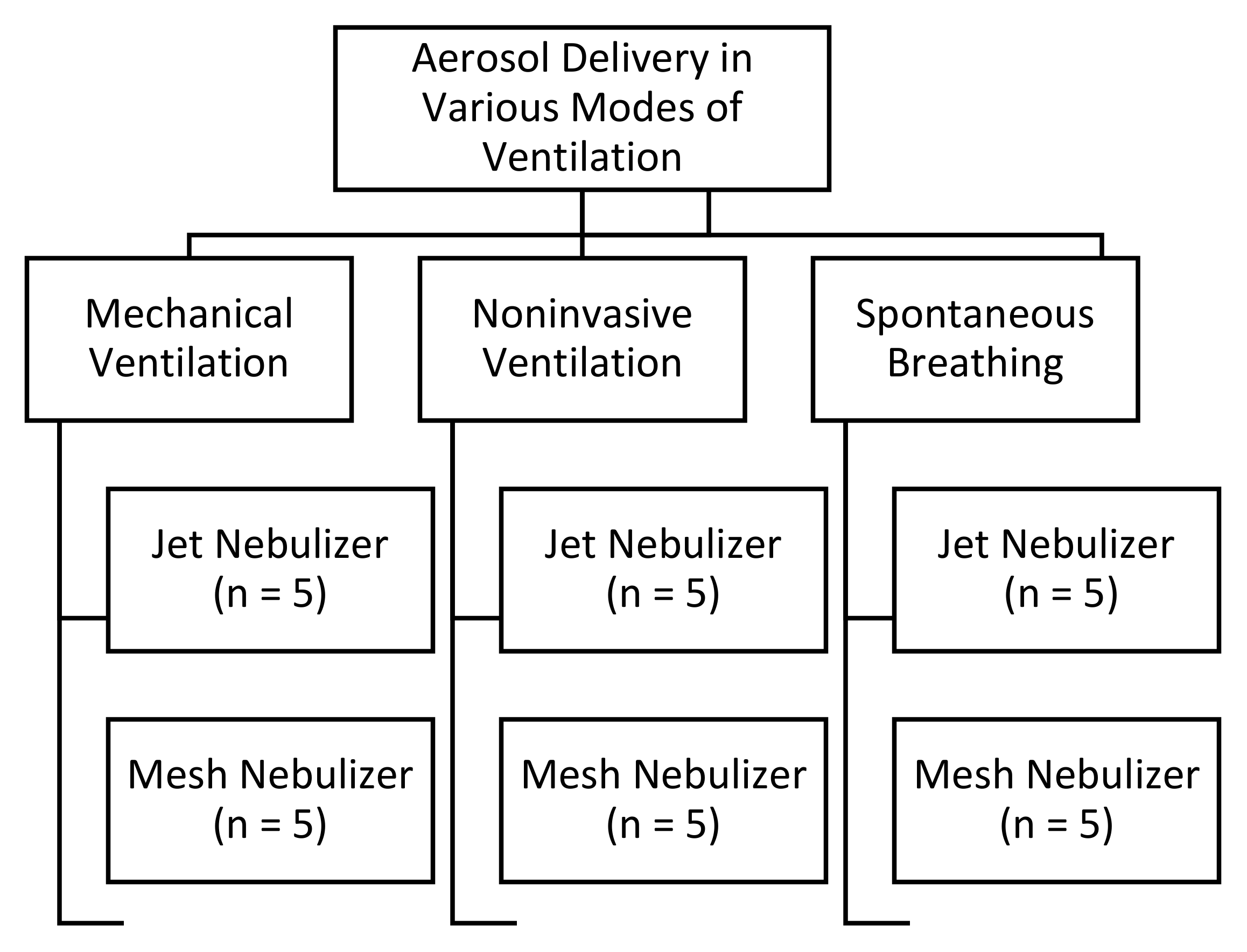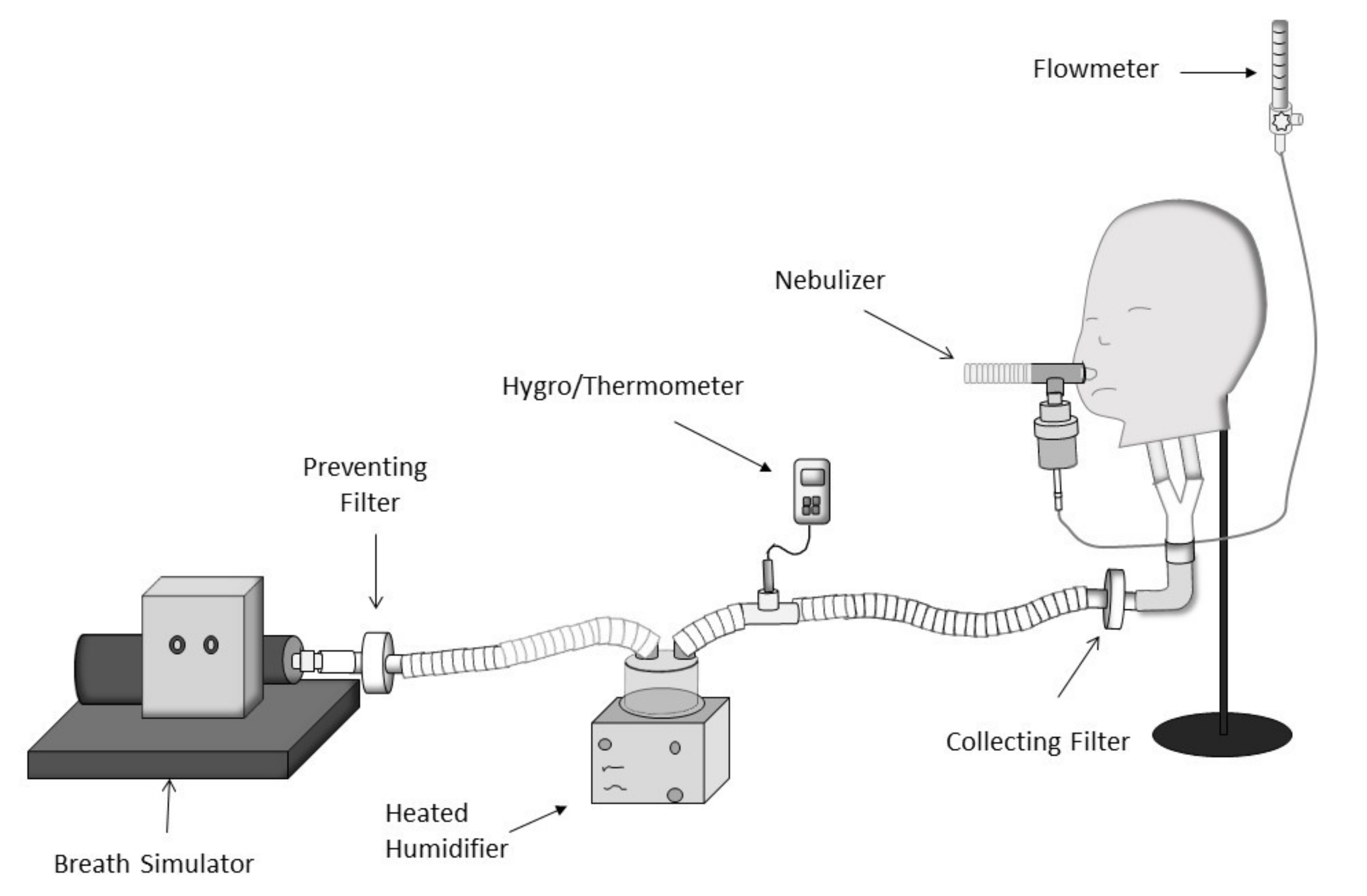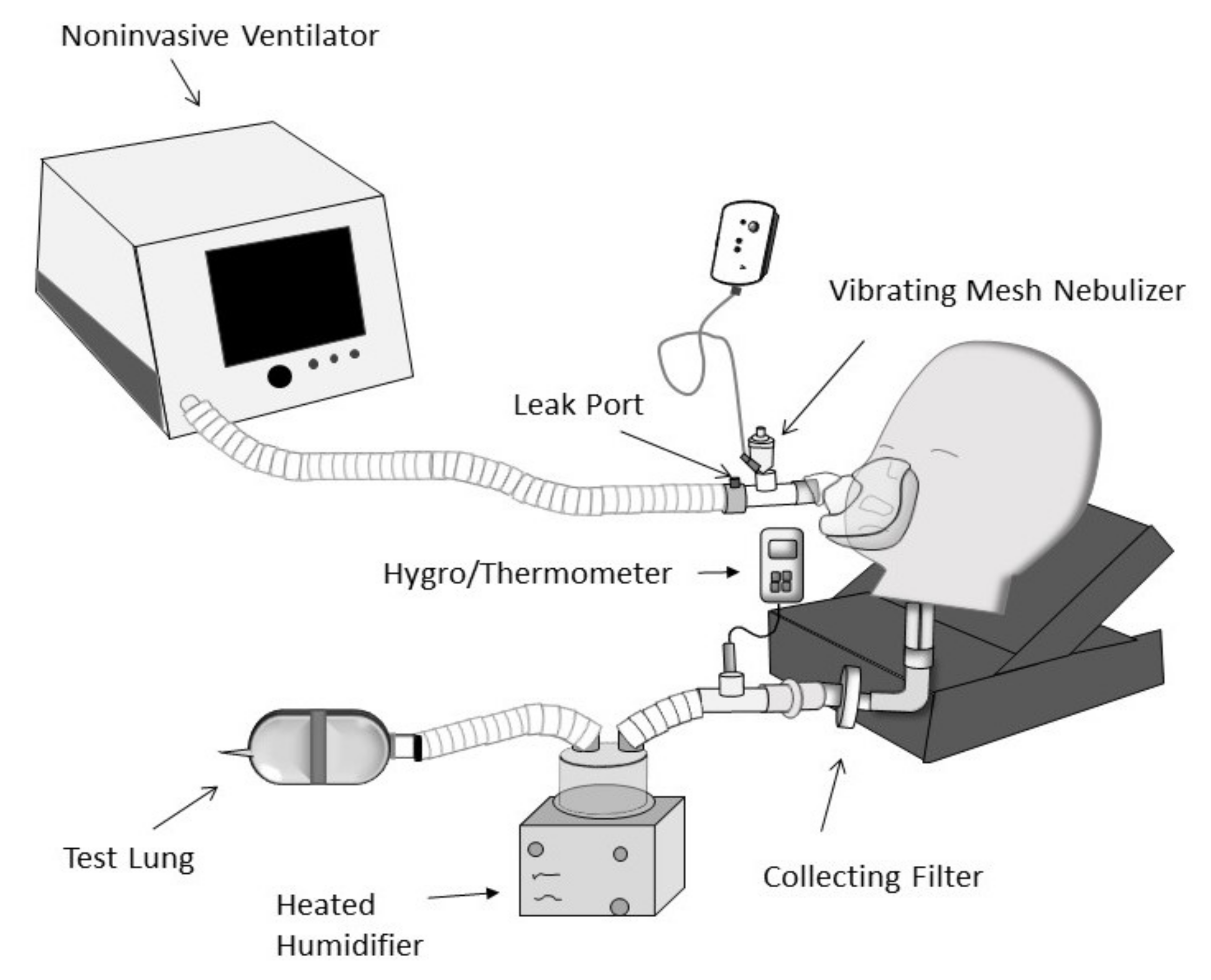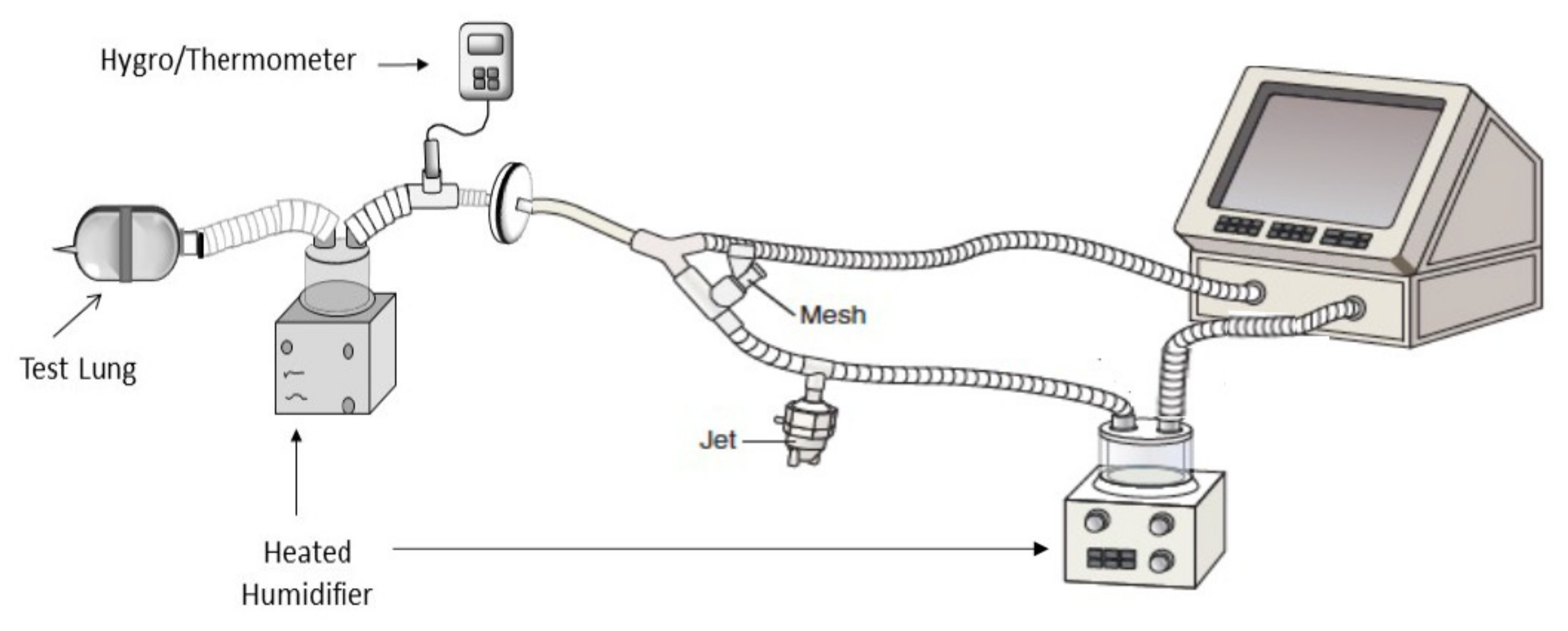Quantifying Delivered Dose with Jet and Mesh Nebulizers during Spontaneous Breathing, Noninvasive Ventilation, and Mechanical Ventilation in a Simulated Pediatric Lung Model with Exhaled Humidity
Abstract
:1. Introduction
2. Materials and Methods
2.1. Lung Models
2.2. Data Collection
2.3. Data Analysis
3. Results
3.1. Impact of Different Types of Ventilation on Lung Dose
3.2. Impact of Nebulizer Type on Lung Dose
4. Discussion
4.1. Aerosol Delivery during Mechanical Ventilation
4.2. Aerosol Delivery during Noninvasive Ventilation
4.3. Aerosol Delivery during Spontaneous Breathing
4.4. Aerosol Delivery with Pediatric vs. Adult Model
5. Conclusions
Author Contributions
Funding
Institutional Review Board Statement
Informed Consent Statement
Data Availability Statement
Conflicts of Interest
References
- Ari, A.; Fink, J.B. Aerosol therapy in children: Challenges and solutions. Expert Rev. Respir. Med. 2013, 7, 665–672. [Google Scholar] [CrossRef]
- Ahrens, R.C. The role of the MDI and DPI in pediatric patients: “Children are not just miniature adults”. Respir. Care 2005, 50, 1323–1328. [Google Scholar]
- Fink, J. Aerosol delivery to ventilated infants and pediatric patients. Respir. Care 2004, 49, 653–665. [Google Scholar]
- Ari, A. A path to successful patient outcomes through aerosol drug delivery to children: A narrative review. Ann. Transl. Med. 2021, 9, 593. [Google Scholar] [CrossRef] [PubMed]
- Amirav, I.; Newhouse, M.T. To inhale or not to inhale: Is that the question? A simple method of DPI instruction. J. Pediatrics 2010, 156, 339-e1. [Google Scholar] [CrossRef] [PubMed]
- Deerojanawong, J.; Na, P.V.; Prapphal, N.; Hanrutakorn, C.; Sritippayawan, S. Evaluation of metered-dose inhaler administration technique among asthmatic children and their caregivers in Thailand. Asian Pac. J. Allergy Immunol. 2009, 27, 87–93. [Google Scholar] [PubMed]
- Hagmolen, H.W.; van de Berg, N.; Bindels, P.; van Aalderen, W.; van der Palen, J. Assessment of inhalation technique in children in general practice:increased risk of incorrect performance with new device. J. Asthma 2008, 45, 67–71. [Google Scholar]
- Walia, M.; Paul, L.; Satyavani, A.; Lodha, R.; Kalaivani, M.; Kabra, S.K. Assessment of inhalation technique and determinants of incorrect performance among children with asthma. Pediatric Pulmonol. 2006, 41, 1082–1087. [Google Scholar] [CrossRef]
- Rubin, B.K. Air and soul: The science and application of aerosol therapy. Respir. Care 2010, 55, 911–921. [Google Scholar] [PubMed]
- Fink, J.B.; Rubin, B.K. Problems with inhaler use: A call for improved clinician and patient education. Respir. Care 2005, 50, 1360–1374. [Google Scholar] [PubMed]
- Ari, A.; Fink, J. Guidelines to aerosol devices in infants, children and adults: Which to choose, why and how to achieve effective aerosol therapy? Expert Rev. Respir. Med. 2011, 5, 561–572. [Google Scholar] [CrossRef] [PubMed]
- Ari, A.; Restrepo, R.D. Aerosol delivery device selection for spontaneously breathing patients: 2012. Respir. Care 2012, 57, 613–626. [Google Scholar] [CrossRef] [PubMed] [Green Version]
- Dolovich, M.B.; Ahrens, R.C.; Hess, D.R.; Anderson, P.; Dhand, R.; Rau, J.L.; Smaldone, G.C.; Guyatt, G.; American College of Chest Physicians; American College of Asthma, Allergy and Immunology. Device selection and outcomes of aerosol therapy: Evidence-based guidelines: American College of Chest Physicians/American College of Asthma, Allergy, and Immunology. Chest 2005, 127, 335–371. [Google Scholar] [CrossRef] [Green Version]
- Laube, B.L.; Janssens, H.M.; de Jongh, F.H.; Devadason, S.G.; Dhand, R.; Diot, P.; Everard, M.L.; Horvath, I.; Navalesi, P.; Voshaar, T.; et al. What the pulmonary specialist should know about the new inhalation therapies. Eur. Respir. J. 2011, 37, 1308–1331. [Google Scholar] [CrossRef] [Green Version]
- Ari, A.; Areabi, H.; Fink, J.B. Evaluation of position of aerosol device in two different ventilator circuits during mechanical ventilation. Respir. Care 2010, 55, 837–844. [Google Scholar] [PubMed]
- Ari, A.; Atalay, O.T.; Harwood, R.; Sheard, M.M.; Aljamhan, E.A.; Fink, J.B. Influence of nebulizer type, position, and bias flow on aerosol drug delivery in simulated pediatric and adult lung models during mechanical ventilation. Respir. Care 2010, 55, 845–851. [Google Scholar]
- Ari, A.; Harwood, R.; Sheard, M.; Alquaimi, M.M.; Alhamad, B.; Fink, J.B. Quantifying Aerosol Delivery in Simulated Spontaneously Breathing Patients With Tracheostomy Using Different Humidification Systems With or Without Exhaled Humidity. Respir. Care 2016, 61, 600–606. [Google Scholar] [CrossRef] [PubMed] [Green Version]
- Ari, A.; Dang, T.; Al Enazi, F.H.; Alqahtani, M.M.; Alkhathami, A.; Qoutah, R.; Almamary, A.S.; Fink, J.B. Effect of Heat Moisture Exchanger on Aerosol Drug Delivery and Airway Resistance in Simulated Ventilator-Dependent Adults Using Jet and Mesh Nebulizers. J. Aerosol Med. Pulm. Drug Deliv. 2018, 31, 42–48. [Google Scholar] [CrossRef]
- Williams, J.P.; Ari, A.; Shanmugam, R.; Fink, J.B. The Effect of Different Closed Suction Catheter Designs and pMDI Adapters on Aerosol Delivery in Simulated Adult Mechanical Ventilation With and Without Exhaled Humidity. Respir. Care 2018, 63, 1154–1161. [Google Scholar] [CrossRef]
- Ari, A.; Alwadeai, K.S.; Fink, J.B. Effects of Heat and Moisture Exchangers and Exhaled Humidity on Aerosol Deposition in a Simulated Ventilator-Dependent Adult Lung Model. Respir. Care 2017, 62, 538–543. [Google Scholar] [CrossRef] [Green Version]
- Ari, A.; Fink, J.B. Delivered dose with jet and mesh nebulisers during spontaneous breathing, noninvasive ventilation and mechanical ventilation using adult lung models. ERJ Open Res. 2021, 7. [Google Scholar] [CrossRef]
- Berlinski, A.; Willis, J.R. Effect of Tidal Volume and Nebulizer Type and Position on Albuterol Delivery in a Pediatric Model of Mechanical Ventilation. Respir. Care 2015, 60, 1424–1430. [Google Scholar] [CrossRef] [PubMed] [Green Version]
- Ari, A. Aerosol Therapy in Pulmonary Critical Care. Respir. Care 2015, 60, 858–874. [Google Scholar] [CrossRef] [Green Version]
- Ari, A.; Fink, J.B. Factors affecting bronchodilator delivery in mechanically ventilated adults. Nurs. Crit. Care 2010, 15, 192–203. [Google Scholar] [CrossRef]
- Ari, A.; Fink, J.B.; Dhand, R. Inhalation therapy in patients receiving mechanical ventilation: An update. J. Aerosol Med. Pulm. Drug Deliv. 2012, 25, 319–332. [Google Scholar] [CrossRef] [Green Version]
- Berlinski, A.; Willis, J.R. Albuterol delivery by 4 different nebulizers placed in 4 different positions in a pediatric ventilator in vitro model. Respir. Care 2013, 58, 1124–1133. [Google Scholar] [CrossRef]
- Berlinski, A.; Velasco, J. Albuterol Delivery Efficiency in a Pediatric Model of Noninvasive Ventilation With a Single-Limb Circuit. Respir. Care 2019, 64, 1366–1370. [Google Scholar] [CrossRef] [PubMed]
- Velasco, J.; Berlinski, A. Albuterol Delivery Efficiency in a Pediatric Model of Noninvasive Ventilation With Double-Limb Circuit. Respir. Care 2018, 63, 141–146. [Google Scholar] [CrossRef]
- Reychler, G.; Michotte, J.B. Development challenges and opportunities in aerosol drug delivery systems in non-invasive ventilation in adults. Expert Opin. Drug Deliv. 2019, 16, 153–162. [Google Scholar] [CrossRef]
- Restrepo, R.D.; Dickson, S.K.; Rau, J.L.; Gardenhire, D.S. An investigation of nebulized bronchodilator delivery using a pediatric lung model of spontaneous breathing. Respir. Care 2006, 51, 56–61. [Google Scholar] [PubMed]
- Cooper, B.; Berlinski, A. Albuterol Delivery via Facial and Tracheostomy Route in a Model of a Spontaneously Breathing Child. Respir. Care 2015, 60, 1749–1758. [Google Scholar] [CrossRef] [Green Version]
- Lin, L.; Restrepo, R.D.; Gardenhire, D.S.; Rau, J.L. Effect of face mask design on inhaled mass of nebulized albuterol, using a pediatric breathing model. Respir. Care 2007, 52, 1021–1026. [Google Scholar] [PubMed]
- Lin, H.L.; Wan, G.H.; Chen, Y.H.; Fink, J.B.; Liu, W.Q.; Liu, K.Y. Influence of Nebulizer Type With Different Pediatric Aerosol Masks on Drug Deposition in a Model of a Spontaneously Breathing Small Child. Respir. Care 2012, 57, 1894–1900. [Google Scholar] [CrossRef] [PubMed]
- Ari, A.; de Andrade, A.D.; Sheard, M.; AlHamad, B.; Fink, J.B. Performance Comparisons of Jet and Mesh Nebulizers Using Different Interfaces in Simulated Spontaneously Breathing Adults and Children. J. Aerosol Med. Pulm. Drug Deliv. 2015, 28, 281–289. [Google Scholar] [CrossRef] [PubMed] [Green Version]
- Lin, H.L.; Harwood, R.J.; Fink, J.B.; Goodfellow, L.T.; Ari, A. In Vitro Comparison of Aerosol Delivery Using Different Face Masks and Flow Rates With a High-Flow Humidity System. Respir. Care 2015, 60, 1215–1219. [Google Scholar] [CrossRef] [PubMed] [Green Version]
- Ari, A. Effect of nebulizer type, delivery interface, and flow rate on aerosol drug delivery to spontaneously breathing pediatric and infant lung models. Pediatric Pulmonol. 2019, 54, 1735–1741. [Google Scholar] [CrossRef] [PubMed]
- Parker, D.K.; Shen, S.; Zheng, J.; Ivy, D.D.; Crotwell, D.N.; Hotz, J.C.; DiBlasu, R.M. Inhaled Treprostinil Drug Delivery During Mechanical Ventilation and Spontaneous Breathing Using Two Different Nebulizers. Pediatric Crit. Care Med. A J. Soc. Crit. Care Med. World Fed. Pediatric Intensive Crit. Care Soc. 2017, 18, e253–e260. [Google Scholar] [CrossRef] [PubMed]




| Type of Nebulizers | Mechanical Ventilation (MV) | Noninvasive Ventilation (NIV) | Spontaneous Breathing (SB) | p-Value |
|---|---|---|---|---|
| Jet Nebulizer (JN) | 4.30 ± 0.61 | 2.97 ± 0.64 | 4.54 ± 0.88 | 0.075 |
| Mesh Nebulizer (MN) | 11.82 ± 0.65 | 7.25 ± 0.20 | 8.94 ± 0.34 | 0.001 |
| p-value | 0.008 | 0.005 | 0.009 |
Publisher’s Note: MDPI stays neutral with regard to jurisdictional claims in published maps and institutional affiliations. |
© 2021 by the authors. Licensee MDPI, Basel, Switzerland. This article is an open access article distributed under the terms and conditions of the Creative Commons Attribution (CC BY) license (https://creativecommons.org/licenses/by/4.0/).
Share and Cite
Ari, A.; Fink, J.B. Quantifying Delivered Dose with Jet and Mesh Nebulizers during Spontaneous Breathing, Noninvasive Ventilation, and Mechanical Ventilation in a Simulated Pediatric Lung Model with Exhaled Humidity. Pharmaceutics 2021, 13, 1179. https://doi.org/10.3390/pharmaceutics13081179
Ari A, Fink JB. Quantifying Delivered Dose with Jet and Mesh Nebulizers during Spontaneous Breathing, Noninvasive Ventilation, and Mechanical Ventilation in a Simulated Pediatric Lung Model with Exhaled Humidity. Pharmaceutics. 2021; 13(8):1179. https://doi.org/10.3390/pharmaceutics13081179
Chicago/Turabian StyleAri, Arzu, and James B. Fink. 2021. "Quantifying Delivered Dose with Jet and Mesh Nebulizers during Spontaneous Breathing, Noninvasive Ventilation, and Mechanical Ventilation in a Simulated Pediatric Lung Model with Exhaled Humidity" Pharmaceutics 13, no. 8: 1179. https://doi.org/10.3390/pharmaceutics13081179
APA StyleAri, A., & Fink, J. B. (2021). Quantifying Delivered Dose with Jet and Mesh Nebulizers during Spontaneous Breathing, Noninvasive Ventilation, and Mechanical Ventilation in a Simulated Pediatric Lung Model with Exhaled Humidity. Pharmaceutics, 13(8), 1179. https://doi.org/10.3390/pharmaceutics13081179







